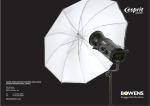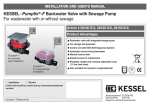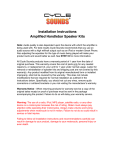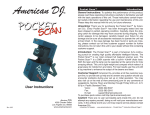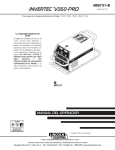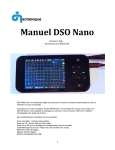Download Bowens ESPRIT 250 Operating instructions
Transcript
355 Old Road Clacton On Sea Essex CO15 3RH Tel: +44 (0)1255 422807 Fax: +44 (0)1255 436342 www.bowens.co.uk ʻBowensʼ ® and ʻthe power behind the pictureʼ ® are registered trademarks of Bowens International Ltd. OPERATING INSTRUCTIONS ESPRIT GEMINI DIGITAL USER GUIDE BWL-0410 (10/06) BOWENS INTERNATIONAL LIMITED Introduction Table of Contents Dear Valued Customer, Description Page Introduction and Safety Notes 3 Thank you for choosing the Bowens Esprit Gemini Digital professional flash system. Control Panel Guide 4 Connecting & Using the Esprit Gemini 5 Mounting 5 Fitting the Modelling Lamp 6 Accurate, ergonomic, powerful and simple to use, the Esprit Gemini Digital was designed by working closely with photographers to develop a flash that meets the standards demanded in professional studios today. All ʻS-Typeʼ accessories from the Bowens range can be used with the Esprit Gemini Digital. For details of all related products, please contact your local distributor, a list of which can be found at www.bowens.co.uk. In order to obtain the full benefit from your purchase, please take a few moments to familiarise yourself with this user manual. Fitting / Removing Reflectors 6 Fuse 6 Synchronisation 6-7 Flash Power Control 7 Modelling Lamp Control 7 Functions Overview 7-8 Normal Functions 9 Advanced Functions 10 Functions Menu System 11 Modelling Lamp Ready Indicator 12 Photocell 12 - 13 Audible Ready Beep 13 Information & Error Codes 13 Additional Information 14 Flash Tube Replacement 14 Battery Power 14 - 15 Pulsar Radio Transmitter 15 Pulsar Clip-On Platform 16 Gemini Accessories 16 - 17 Specifications 18 - 19 2 www.bowens.co.uk Thank you. Bowens International Ltd. Safety Notes DO NOT: • Use in an environment where moisture or flammable vapour is likely to come in contact with the unit. • Plug the Gemini Esprit Digital into a mains supply and a battery at the same time. • Restrict air vents while in use. • Use a unit with damaged housing, mouldings, flash tube or modelling lamp. If the unit is dropped or damaged in any way, always have it checked out before using. DO: • Read Instructions before use • Switch power off and disconnect from the supply before changing modelling bulb or flash tube. • Disconnect the supply before changing the fuse. Never replace with a fuse of a different rating. A spare fuse is fitted in the fuse holder. • Exercise care when handling equipment that has been in use. The reflector and front end of the unit can become very hot. • Avoid placing cables where they can be tripped over. Protect from heavy, sharp or hot objects, which may cause damage and replace damaged cables immediately. • Due to the high voltage / high energy used in all Esprit units, all servicing must be carried out by an authorised Service Centre. • Remove the power cord by gripping the plug. NEVER pull the cord. • Ensure that any extension cord used has a suitable current rating to prevent overheating and never use coiled extension cords. • ALWAYS remove the flash head covers before using. www.bowens.co.uk 3 Connecting & Using the Esprit Gemini Digital Control Panel Guide !!! WARNING HIGH VOLTAGE !!! Rear Control Panel Mains / Battery Power Select Carry Handle NEVER CONNECT THE ESPRIT GEMINI DIGITAL TO BOTH A MAINS SUPPLY AND A BATTERY SUPPLY AT THE SAME TIME. THIS APPLIANCE MUST BE EARTHED WHEN USED WITH MAINS. DISCONNECT THE MAINS LEAD WHEN CHANGING MODELLING LAMPS & FLASH TUBES. The Esprit Gemini Digital unit may be operated either on a mains supply or with a Bowens battery source such as the Bowens Travel-Pak, Turbo-Pak or the Explorer 1500. Mains Inlet Sync Socket Fuse (and spare fuse) Battery Power Inlet Side Control Panel For mains operation, the mains switch (page 4) should be in the upper position (I). For battery operation the switch should be in the lower position (II). The centre position is OFF (O). NOTE: When operated from a battery source, the modelling lamp functions are not available. When connecting a power supply ensure the power is OFF. Connect the unit using the appropriate cabling. If using a battery source, ensure the connector locks are fully tightened. Switch the power source on, then switch on the unit. The unit will charge and indicate it is ready for use. Press the TEST button to check the unit fires. Mounting Photocell Mount the Esprit Gemini Digital unit on selected support system. The mounting bush on the 'L' bracket allows for two possible ways of mounting to the stand / support. Method B may be found useful if the light is required to point down. Latch Release LED Display Flash Test / Done Button Menu Button Rotary Dial A 4 www.bowens.co.uk B www.bowens.co.uk 5 Synchronisation cont. Fitting the Modelling Lamp Switch off and disconnect from the supply. Screw modelling lamp into ES lampholder in the centre of the reflector. Allow lamp to cool before removing. Note: It is recommended that a Photoflood or Halostar bulb with a maximum wattage of 275W is used. Bowens will not accept liability on the use of any lamp with a greater wattage than 275W. Fitting / Removing Reflectors A wide range of reflectors are available for the Esprit range. To fit, slide the neck of the reflector over the front of the unit. Align the three pegs on the reflector with the three slots in the retaining ring. Press down and turn clockwise to lock. To remove reflector, pull back Latch Release Key (page 4), turn the reflector fully anti-clockwise and withdraw. If an umbrella is to be used a 'Wide Angle Reflector' should be fitted and the umbrella fitted through the mounting hole in the mounting bracket and locked in position with the knurled screw. Note: Take care when fitting / removing reflectors not to damage the flashtube assembly. The flashtube is very delicate, avoid unnecessary handling of the glass tube. Always switch off and disconnect from the mains supply before fitting and changing reflectors. Sync Socket: The standard quarter inch jack type socket on the rear panel of the unit may be used for direct connection to a camera set to 'x' synchronisation. Two Esprit units may be connected together using a 'y' connector. An Infra Red Receiver, Omnicell or Pulsar Radio Trigger systems may also be plugged into this socket. The socket operates at +5V and is safe for use on digital cameras. Open Flash: For testing or multiple flash applications the Open Flash Push button can be used. Flash Power Control The flash power output is variable over five f-stops from full to 1/32 power, in 1/10 stop increments. The maximum power available depends upon the model (See specification table). The Flash Power output value which is shown on the side of the unit can be set to be displayed in either f-stops or Joules (Ws). The Flash Power display setting can be changed via the ʻAdvanced Functionsʼ in the menu system. The Flash Power display can also be ʻinvertedʼ so it is displayed upside down. This is a useful feature when using the unit from a ceiling mounted rail system when the unit will be upside down. This feature is available through the Advanced Functions menu. Note: If the unit is subjected to rapid operation over extended periods, it may automatically go into an overheat condition. In this condition the charging and modelling functions are disabled in order to allow the unit to cool. The unit will automatically resume operation once cooled sufficiently. Warning High Voltage! Do not touch the flashtube assembly for thirty minutes after disconnecting from supply. Modelling Lamp Control Fuse The modelling and flash circuitry is protected by a single 20mm fuse mounted on the rear panel. Never replace the fuse with one of a different rating. As the fuse may blow when the modelling lamp fails always check the fuse when replacing the bulb. A spare fuse is supplied and located in the fuse holder at the back of the unit. Always switch OFF and disconnect the Esprit Gemini unit from the power supply before changing the bulb or fuse. The modelling lamp control options are available within the ʻnormal functionsʼ through the digital display on the side of the unit. The modelling lamp options that are available are either OFF, USER (in USER mode the modelling lamp output can be set from F5.0 to F10.0), PROPORTIONAL (modelling lamp automatically adjusts itself to be in proportion to the flash power output), or FULL (the modelling lamp is set to maximum power output). Note: The modelling lamp can only be used when the unit is operating from mains power, when the unit is working from battery power the modelling lamp options are disabled. Synchronisation Functions Overview There are several ways to trigger the Esprit Gemini Digital GEMINI Digital User Controls Photocell: The Esprit Gemini has a built in switchable photocell enabling the unit to be triggered by the flash from any other flash unit or a small camera mounted flash gun. The photocell is mounted behind the red transparent cover on the top of the unit. The Photocell has various trigger modes, see page 12 for full details. 6 www.bowens.co.uk The ʻFlash Powerʼ, ʻModelling Lampʼ and ʻOther Optionʼ settings are all available by using the ʻrotary controlʼ on the side of the unit in combination with the ʻMENUʼ and the ʻDONEʼ button; all of the options and settings can be seen via the 7-segment LED display above the buttons. All of the various options and settings are stored to the unitʼs memory. www.bowens.co.uk 7 Normal Functions Functions Overview During normal use simply rotate the dial to adjust the power to the required level. The unit ready indication is by means of a ʻsteadyʼ display and a sounder beep (if on) as well as the modelling lamp indication function when the unit reaches ready (if switched on). While changing the power level the display flashes at different rates to indicate whether the unit is charging or if there is excess power that needs dumping. The display will flash ʻquicklyʼ while the unit is charging and flash ʻslowlyʼ to indicate that there is excess power that needs to be dumped. To test the flash and/or dump any excess power press the ʻTESTʼ button. Function Display *Lamp LP Off (OFF) - Lamp remains ʻoffʼ during operation. USER (USR) - In ʻuserʼ mode the modelling lamp can be adjusted from f5.0 to f10.0 Proportional (PRO) - In ʻproportionalʼ mode the modelling lamp will automatically adjust itself to the same output level as the flash. The unit can be triggered via the ʻsync socketʼ connected to the relevant system or via the ʻPhotocellʼ as required. Other displays may occur during operation to provide warnings of problems or to indicate the unit status. To change any of the unitʼs settings first press the ʻMENUʼ button on the side of the unit; ʻSETʼ will be displayed briefly showing that the unit is entering the user setup options followed by ʻLPʼ (for ʻLamp settingsʼ) as the first item. Each press of the ʻMENUʼ button takes you down one level of the menu structure until you cannot go any further; at this point the sounder (if switched on) will provide a warning beep. Description Full (FUL) - When the modelling lamp is set to ʻfullʼ the power output will remain at the maximum level. *Lamp Ready Indication IND Off (OFF) - No lamp ready indication. Intermittent (INT) - If modelling lamp is on it goes off after the unit has fired and comes back on at the set level once the unit has recharged. At any menu level turning the rotary control will either select another function/option or change the setting of the chosen function. Each press of the ʻDONEʼ button takes you up one level until you exit the user setup mode, at which point ʻEndʼ is displayed. Any altered user setting will be saved to the units memory. See below illustration for example of how to change the Modelling Lamp settings to off. Pulse (PUL) - Modelling lamp pulses when the unit has recharged after firing. Example Illustration: How to change the Modelling Lamp to off. Ready Sounder Step One. During normal operation press the MENU button to enter the normal functions menu. Step Four. Next turn the rotary dial again to find the desired option of the setting you wish to change. Step Two. Next, turn the rotary dial to scroll through the normal functions. Step Five. Scroll through the available options until the desired setting is shown. SND Off (OFF) - The Ready Sounder beep remains off and does not indicate when the unit has charged. Intermittent (INT) - The unit emits a short beep when it has fully recharged to indicate that it is ready to fire again. Continuous (CON) - The unit emits a continuous beep while it is recharging and stops once fully recharged. Photocell PHO Off (OFF) - Photocell remains ʻoffʼ. 1st (1st) - Photocell is set to trigger unit on the first flash detected. Step Three. Once the desired setting is shown press the MENU button again to enter the available functions for that particular setting. 8 www.bowens.co.uk Step Six. Next press the TEST/DONE button to confirm your selection and go up one menu level. Repeat as necessary with other functions. Finally press TEST/DONE until END is displayed. 2nd (2nd) - Photocell is set to trigger on the second flash detected. 3rd (3rd) - Photocell is set to trigger on the third flash detected. 4th (4th) - Photocell is set to trigger on the fourth flash detected. * Only available when operating from mains power. www.bowens.co.uk 9 Functions Menu System Advanced Functions Menu Top Level Function Display Description Press ‘Menu’ *LP Audio (Key Clicks & Warnings) AUD Off (OFF) - All audible beeps/clicks are turned off during normal operation i.e. while scrolling through the functions menu. On (ON) - All audible beeps/clicks are enabled while unit is powered on. Power Display UNT to enter options Press ‘Test/Done’ OFF, USR, PRO, FUL to exit options Rotate Dial to scroll through functions set from F-5 to F-10 *IND OFF, INT, PUL SND OFF, INT, CON f-stops (F-S) - Power output is displayed in f-stops. Joules (JOU) - Power output is displayed in Joules (Ws). OFF, 1st, 2nd, 3rd, 4th PHO Display Invert INV Off (OFF) - LED display invert option remains ʻoffʼ during operation. On (ON) - LED display is inverted and is shown upside down. Flash Dump Fld set time window from 10 to 990ms ADV Off (OFF) - Unit will not automatically dump any excess power. AUD OFF, ON On (ON) - The unit will automatically dump any excess power stored in the capacitors after the user has turned down the power. UNT F-S, JOU INV OFF, ON FLD OFF, ON * Only available when operating from mains power. 10 www.bowens.co.uk www.bowens.co.uk 11 Photocell Modelling Lamp Ready Indicator The modelling lamp can be used as an indicator of when the unit has flashed, and also when it has charged and is ready to fire again. All modelling lamp options are only available when the unit is operating from mains power. The available options for the modelling lamp ready indicator are: Off (OFF) - No lamp ready indication; the modelling lamp remains on or off during operation depending on ʻLampʼ settings. Intermittent (INT) - Modelling lamp goes off after unit has fired and comes back on when fully recharged. Intermittent indication is only available if the lamp setting is ʻonʼ. Pulse (PUL) - Now press ʻMENUʼ again to go back to displaying ʻPhoʼ. Press ʻTESTʼ to save the settings. If the camera or camera settings are ever changed just repeat the procedure to check and/or set the flash unit again. This system may require some experimentation by the user to get the correct flash in the sequence and the timeout sensitivity right for a give camera and flash situation. E.G. The Canon EOS10D gives an exposure measuring pre-flash first, followed 75mS later by the main flash. This means that if the unit is set to trigger on the first flash then the unit will always trigger but the Canon shutter will not open until 75mS later resulting in an incorrect exposure. If the unit is set to 2nd flash then the exposure will be correct. Setting it to 3rd or 4th means that the unit will never trigger and any exposure will again be incorrect. Lamp pulses once fully recharged after firing. The pulse ready indicator option is available whether the ʻLampʼ settings are on or off. Audible Ready Beep Photocell The Photocell is a light sensitive trigger which allows the photographer a way of triggering their stand alone flash heads that are not syncʼd by a cable. The photocell (when on) triggers the unit when another flash or light source is detected (i.e. when another flash head is fired and the photocell detects this it will fire the unit in synchronisation with the original light source). The Photocell on the Gemini Digital has an option to enable camera pre-exposure flashes to be ignored. These are used for exposure measurement and/or red eye reduction. This allows the flash unit to be synchronised to the camera shutter on the 1st, 2nd, 3rd or 4th flash selected by the user. (this option is for those who wish to trigger theIr flash heads without a radio or IR triggering system or without a sync cable). 1st is the normal ʻinstantʼ trigger where only one flash is used coincident with the shutter. Where two or more flashes are to be detected a ʻtime windowʼ is started on detection of the first flash in the sequence. If the required number of flashes are detected within the ʻtime windowʼ then the unit is triggered on the last flash and the system is reset to wait for the next flash. If fewer than the required flashes are detected then the system is reset at the end of the time window. The ʻtime windowʼ can be set by the user from 10mS to 990mS for 2, 3 or 4 flashes. For obvious reasons there is no actual time window for a single flash since the unit triggers as soon as the flash is detected. As well as being able to select the number of flashes manually, the unit can also ʻlearnʼ the number of required pre-exposure flashes produced by any camera. This is done by setting the number of flashes to 1st. This provides the maximum detection window of 990mS when in ʻlearnʼ mode. While carrying out the following procedure ensure that no other flash is likely to be used in the vicinity until the settings have been saved. To allow the flash unit to learn the camera characteristics first set up the camera in the required mode (i.e. flash, pre-flash, red-eye reduction etc). Now press ʻMENUʼ on the flash head and rotate the dial to select the ʻPhoʼ function and press ʻMENUʼ again, the current ʻPhoʼ option will now be shown; set the unit to 1st flash. Now press the shutter release fully with the camera facing the unit. The number of pre-flashes detected will be shown on the display. N.B. if more than 4 flashes are detected within the time window then the photocell will be turned off. Press the ʻMENUʼ button and the flash detection timeout period will now be shown (2,3 and 4 only). Rotate the dial to obtain the required value - typically the default of 300mS should be adequate for most cases. 12 www.bowens.co.uk There is an Audible Ready Beep signal which is available to provide either a short beep to indicate when the unit is charged and ready to fire at the desired power output or sound continuously when charging. The Audible Ready Beep options are available through the Normal Functions on the unit. Information & Error Codes . The following normal displays and error codes are displayed together with a sound if appropriate and if ʻSoundʼ & ʻAudioʼ are switched ʻonʼ. Display X-X or XX- Description Power display in either digital f-stops or Joules (Ws), in Lamp User setup mode this shows the equivalent power setting of the modelling lamp but always in digital f-stops. If this display is steady then this indicates the unit is READY and can be flashed. If this display is flashing quickly then this indicates that the unit is charging to the required setting. If this display is flashing slowly then this indicates the flash power needs to be dumped.(this can be done automatically by setting ʻFldʼ to ʻonʼ or manually by pressing the ʻTESTʼ button). ʻChrʼ Displayed after a successful flash whilst charging. ʻHotʼ Unit is in overheat and will automatically reset when cooled. ʻEr1ʼ Failure to charge correctly at ʻswitch-onʼ. Long sounder if on. This could be due to low mains input or leaky capacitors. After retrying and rechecking a number of times the unit will automatically lock out with the display showing ʻEr1ʼ but with the sounder silenced. ʻEr2ʼ Failure to charge correctly after a flash (sound if on). The most likely cause here is that the tube glowed on. After retrying for a number of times and each time applying a longer glow stop period the unit will automatically lock out with the display showing ʻEr2ʼ but with the sounder silenced. ʻEr3ʼ Failure of the tube to fire (sound if on). www.bowens.co.uk 13 Battery Power Additional Information Notes: Setting ʻFldʼ to ʻonʼ will automatically flash the unit to dump any excess energy if the user reduces the power output setting and makes no further adjustments within 2 seconds. The modelling lamp has a micro controlled soft ʻonʼ and ʻoffʼ to prolong the life of the bulb. The ʻkey clickʼ & ʻwarning sounderʼ can be turned ʻonʼ or ʻoffʼ independently of the ʻreadyʼ sounder. This option is available within the Advanced Functions. The Bowens Explorer 1500 represents the state-of-the-art in portable battery generator technology. Weighing just under 12kg, this petite powerpack boasts an enviable power-to-size ratio and recycling capacity while providing photographers with the flexibility of two independent digitally controlled channels for use with Bowens Quad heads, both with 1/10 stop increment and accuracy. In addition, two Bowens Gemini sockets allow the photographer anything up to four light sources and a massive 3000Ws from this feature rich pack. Total freedom and flexibility, whenever and wherever quality light is required. Flashtube Replacement Explorer Battery Generator Ensure that the unit is switched off and disconnect from the mains supply and then wait thirty minutes before touching/removing the flashtube. BW7640 Also Available for the Bowens battery range: Remove the protective cap and unwind the twisted wire from the flashtube support. Travel-Pak Boost Battery Spare Explorer Battery Travel-Pak/Explorer to Gemini Spare Cable Bowens Universal 2Amp SLA Charger Car Charger Gently pull the flashtube assembly out of the unit. To replace the assembly, hold the flashtube as shown and taking care to support both legs gently but firmly push the flashtube into position. Next wind the trigger wire around the flashtube support. Always replace with the correct flashtube assembly. BW7635 BW7642 BW7632 BW1227 BW1245 Pulsar Radio Trigger With the Esprit Gemini Digital monolights you are free from mains power. With the Pulsar Radio Trigger system you can be free from sync cables too. Spare/Replacement Flashtubes. BW2032 UV coated BW2030 Clear This multifunctional device can be used to trigger flash units, film and digital cameras and light meters up to 100m away. Battery Power The Esprit Gemini Digital is great studio monolight, but what about if you need to work out on location? Thanks to Bowens handy battery packs, your Bowens Esprit Gemini Digital units can leave the studio to go on location anytime, anywhere. Included in Bowens range of battery packs are the Travel-Pak and the larger Travel-Pak+. With a fast / slow charge option to prolong the life of the battery as well as a stylish carry bag offering protection from the elements and up to 3 inches of water; no location photographer should be without these handy packs. Travel-Pak Travel-Pak+ 14 www.bowens.co.uk Because the Pulsar is a radio transmitter rather than IR, it allows for triggering around corners or through walls and is not affected by high ambient light situations. Choose from four individual channels and six studio setting per channel, each providing a unique ID for different flash devices or combine them to trigger all equipment within a given setup or studio. Because of its low-voltage operation, it is perfect for digital cameras. Each unit can be used as either a transmitter or receiver and operates using only two AAA batteries. Pulsar Pulsar (Twin Pack) BW5150 BW5160 BW7631 BW7638 www.bowens.co.uk 15 Accessories Pulsar Clip-On Platform With The Pulsar clip-on platform is a handy way of attaching your radio trigger units to almost anything around your studio or even whilst out on location. Simply attach your loose Pulsar unit to the platform and clip onto whatever you need to. A great way of saving valuable time and effort in the studio. 65° Maxilite Reflector This is a good general-purpose direct reflector with an even coverage and a high light output. Since it has a small 20cm (8”) diameter, the light it produces is moderately high in contrast. The stippled surface ensures a smooth and even light distribution. BW1887 BW5155 Accessories Backlite Reflector 75° Softlite Reflector This 15” matt-finished reflector is supplied with a double diffuser cap that covers the flash tube and modelling lamp for added softness. The softest of Bowensʼ direct reflectors, it is perfect for portraiture, beauty and small product photography. The diffuser cap can be removed, making it an excellent large-diameter direct reflector. BW1899 With its 20 x 30.5cm (8 x 12”) elliptical shape, this reflector produces an oval pool of light that can be used to create a natural vignette on a background or other areas. Two fitted spring clips allow colour gels to be fitted. BW2560 A set of colour gels including seven popular colours, a neutral-density filter and two diffusers for heightened lighting creativity is also available for the Backlite reflector. BW2552 Grid Diffuser This is an accessory to the 75° Softlite reflector that creates a unique lighting effect by including a Perspex outer diffuser with a honeycomb and grid in the centre. The Grid Diffuser gives a pool of direct light in the centre of the image, surrounded by softdiffused light. The ratio between the centre and edge is 3:1 - ideal for portrait applications. BW1866 40° Sunlite Reflector A 43cm (17”) white-painted reflector designed to replicate sunlight for photographing items such as architectural models. The white painted interior of the Sunlite helps to ensure that an even light is delivered. BW1868 High-Performance Reflector This 32cm reflector achieves the maximum amount of light output possible for lighting large groups and bouncing light off of high ceilings. The efficient parabolic design delivers a narrow, bright beam of light with intense shadows and high contrast. A must where sheer power is required. BW1878 16 www.bowens.co.uk DID YOU KNOW? that Bowens have over 40 light shaping tools and accessories available for all their monolights that use the current ʻSʼ type accessory fitting. Included among the range of accessories are a wide variety of reflectors and softboxes. For more information visit the website on www.bowens.co.uk www.bowens.co.uk 17 Specifications Specifications Unit GMD250 GMD500 BW3700 BW3705 BW3710 BW3715 Stored Energy (max) 250Ws 500Ws Sync Voltage 5V 5V Flash Colour Temperature 5600K ±300K 5600K ±300K Circuit Protection 230V - 5A (F) (117V - 10A (T)) 230V - 5A (F) (117V - 10A (T)) Supply Voltage Range 230V (117V) 190-250V AC 50Hz (95-130V AC 60Hz) 190-250V AC 50Hz (95-130V AC 60 Hz) 56.1 79.8 0.81 (1.1) secs 1.54 (1.95) secs Modelling Power Control Full / Intermittent / Off Full / Intermittent / Off Flash Duration (t=0.5) (Full power) 1/1315 1/925 Flash Power Control Full to 1/32 5 stops Full to 1/32 5 Stops Modelling Lamp Max 275W Max 275W Ready Indication 100% 100% User Replaceable Flash Tube Clear = BW2030 UV = BW2032 Clear = BW2030 UV = BW2032 Photocell On/Off On/Off Audio Ready Signal On/Off On/Off Recommended Modelling Lamps 275W Photoflood 250W Halostar 275W Photoflood 250W Halostar Weight 2.9Kg 3.4Kg Dimensions (l x w x h) 365 x 145 x 130mm 365 x 145 x 130mm Part Number (230V) (117V) Guide Number (Full power, 50° Keylite, ISO 100) Typical Recycle Time Full Power, 230V, 50Hz (117V 60Hz) Due to our policy of constant product improvement, Bowens International reserves the right to change equipment specifications at any time and without notice. 18 www.bowens.co.uk www.bowens.co.uk 19










